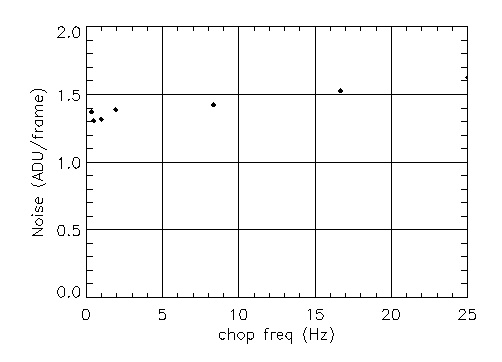For the first time in over a year, we opened the LWS dewar in
March in order to fix several nagging problems. The instrument
was reinstalled in the Forward Cassegrain Module and on sky
engineering time was used 17-18 Mar to check out the
instrument. In general the dewar service was highly
successful. Some of the problems that have plagued the
instrument in recent months were improved upon or completely
eliminated. The following areas were shown to have significant
improvement:
Detector Read Noise
The detector read noise was reduced by nearly a factor of 2,
from 1.3 DN (2600 e-/s) to 0.7 DN
(1400 e-/s). The non-Gaussian noise patterns have been
significantly improved and the data now have normal-looking
photon noise. The high levels of noise and their non-Gaussian
nature had rendered the HRES spectroscopy mode of the instrument
virtually useless. We now expect the HRES mode and the LRES mode
to perform at the design expectations. Standard star data were
taken during the engineering nights that followed the dewar
service. The data are currently being analyzed but preliminary
results show that the noise reduction has improved significantly
the performance of the instrument in spectroscopy modes as well
as in imaging modes. The modification made to the electronics
that resulted in the improved noise was the addition of a filter
board in the dewar. The board consists of low-pass filters on
every bias line. The filter board is located inside the hermetic
connector box, outside the LHe and LN2 cold shields and under
vacuum.
Filters
The filter compliment available to LWS observers has been
significantly improved. The 17.9 µm (2.0 µm
bandwidth) filter, which was previously thought to be
disintegrating, was found to be out of position in the filter
wheel. The mis-alignment was causing unfiltered light to be
transmitted to the detector. The position of the filter was
repaired and this filter now appears to be performing quite
well. At a central wavelength of 17.9 µm, this filter
should help programs that require observations in the 20
µm atmospheric window, a region of the spectrum LWS
filters were lacking. Its relatively wide bandpass of 2.0
µm should make it quite sensitive as well (sensitivity
numbers will be forthcoming on the LWS web page). We were also
able to acquire and install filters on loan from UCSD at 20.0
and 22.0 µm (1.0µm wide). Both the 20.0 and 22.0
µm are undersized for LWS resulting in approximately 40%
loss of transmission and an expansion of the PSF. The
usefulness of these filters remains to be seen, especially since
the 17.9 µm is now OK, but at least will provide more
options to users.
Optical Alignment and Mechanism Rework
Prior to the service mission, the instrument was experiencing
some vignetting problems resulting in about a 15% loss of field
of view. LWS was also having troubles with mechanism
performance. A successful optical alignment procedure was
performed during the service mission and the vignetting problem
has been eliminated. Other work done to the mechanisms has also
shown improvement in the areas of homing and
repeatability. 
Back to:



